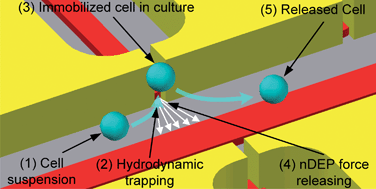Microfluidic single-cell cultivation chip with controllable immobilization and selective release of yeast cells†
Abstract
We present a microfluidic cell-culture chip that enables trapping, cultivation and release of selected individual cells. The chip is fabricated by a simple hybrid glass-SU-8-PDMS approach, which produces a completely transparent microfluidic system amenable to optical inspection. Single cells are trapped in a microfluidic channel using mild suction at defined cell immobilization orifices, where they are cultivated under controlled environmental conditions. Cells of interest can be individually and independently released for further downstream analysis by applying a negative dielectrophoretic force via the respective electrodes located at each immobilization site. The combination of hydrodynamic cell-trapping and dielectrophoretic methods for cell releasing enables highly versatile single-cell manipulation in an array-based format. Computational fluid dynamics simulations were performed to estimate the properties of the system during cell trapping and releasing. Polystyrene beads and yeast cells have been used to investigate and characterize the different functions and to demonstrate biological compatibility and viability of the platform for single-cell applications in research areas such as systems biology.


 Please wait while we load your content...
Please wait while we load your content...